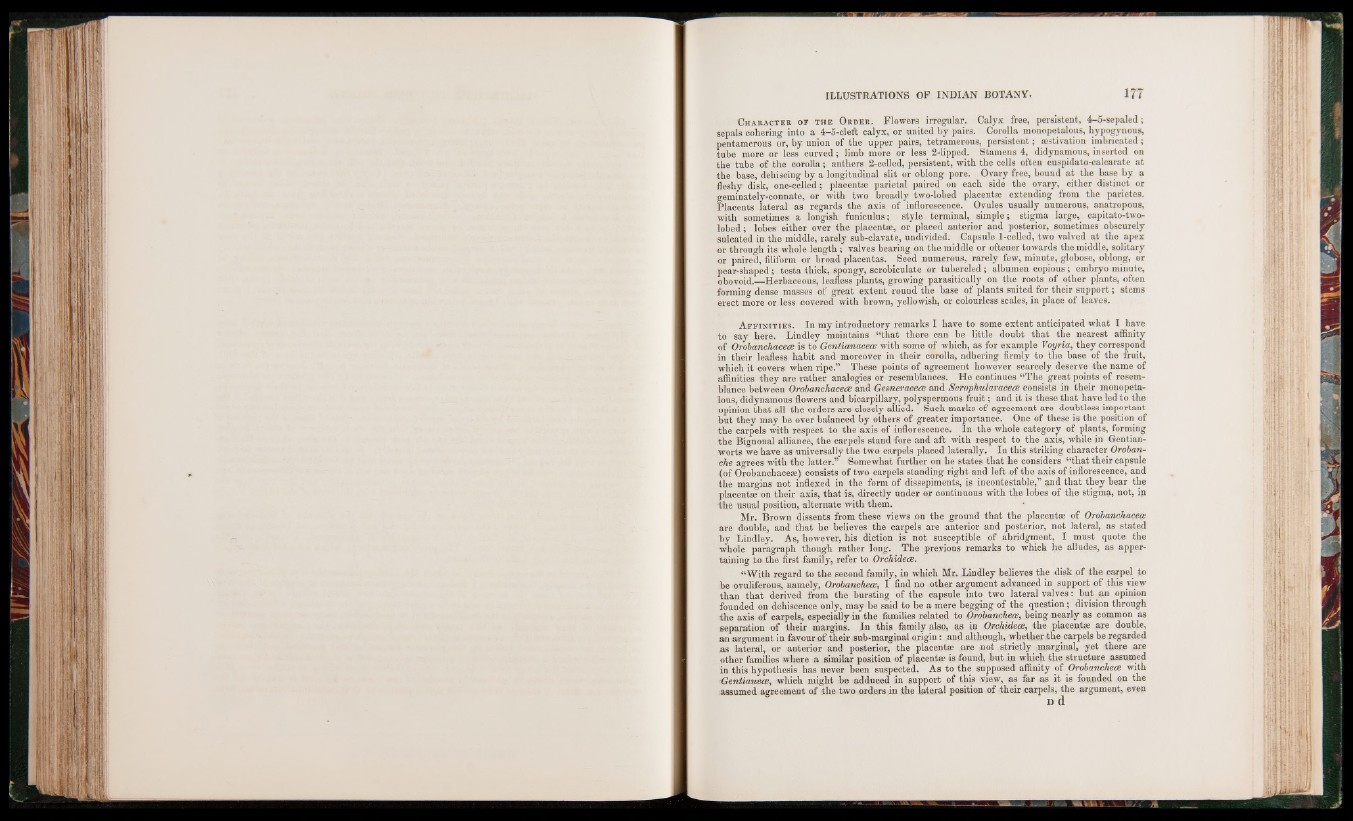
C h a r a c t e r o f t h e O r d e r . Flowers irregular. Calyx free, persistent, 4-5-sepaled;
sepals cohering into a 4-5-cleft calyx, or united by pairs. Corolla monopetalous, hypogynous,
pentamerous or, by union of the upper pairs, tetramerous, persistent; aestivation imbricated;
tube more or less curved; limb more or less 2-lipped. Stamens 4, didynamous, inserted on
the tube of the corolla; anthers 2-oelled, persistent, with the cells often cuspidato-calcarate at
the base, dehiscing by a longitudinal slit or oblong pore. Ovary free, bound at the base by a
fleshy disk, one-celled; placentae parietal paired on each side the ovary, either distinct or
geminately-connate, or with two broadly two-lobed placentas extending from the parietes.
Placents lateral as regards the axis of inflorescence. Ovules usually numerous, anatropous,
with sometimes a loDgish funiculus; style terminal, simple; stigma large, capitato-two-
lobed; lobes either over the placentas, or placed anterior and posterior, sometimes obscurely
sulcated in the middle, rarely sub-clavate, undivided. Capsule 1-celled, two valved at the apex
or through its whole length; valves bearing on the middle or oftener towards the middle, solitary
or paired, filiform or broad placentas. Seed numerous, rarely few, minute, globose, oblong, or
pear-shaped; testa thick, spongy, scrobiculate or tubercled; albumen copious; embryo minute,
obovoid.__Herbaceous, leafless plants, growing parasitically on the roots of other plants, often
forming dense masses of great extent round the base of plants suited for their support; stems
erect more or less covered with brown, yellowish, or colourless scales, in place of leaves.
A f f in i t i e s . In my introductory remarks I have to some extent anticipated what I have
to say here. Lindley maintains “that there can be little doubt that the nearest affinity
of OrobanchacecB is to Gentianacece with some of which, as for example Voyria, they correspond
in their leafless habit and moreover in their corolla, adhering firmly to the base of the fruit,
which it covers when ripe.” These points of agreement however scarcely deserve the name of
affinities they are rather analogies or resemblances. He continues “The great points of resemblance
between OrobanchacecB and Gemeracece and Scrophularacece consists in their monopetalous,
didynamous flowers and bicarpillary, polyspermous fruit; and it is these that have led to the
opinion that all the orders are closely allied. Such marks of agreement are doubtless important
but they may be over balanced by others of greater importance. One of these is the position of
the carpels with respeet to the axis of inflorescence. In the whole category of plants, forming
the Bignonal alliance, the carpels stand fore and aft with respect to the axis, while in Gentian-
worts we have as universally the two earpels placed laterally. In this striking character Oroban-
che agrees with the latter.” Somewhat further on he states that he considers “that their capsule
(of Orobanchaceas) consists of two carpels standing right and left of the axis of inflorescence, and
the margins not indexed in the form of dissepiments, is incontestable,” and that they bear the
placentae on their axis, that is, direetly under or continuous with the lobes of the stigma, not, in
the usual position, alternate with them.
Mr. Brown dissents from these views on the ground that the placenta? of Orohanchacea:
are double, and that he believes the carpels are anterior and posterior, not lateral, as stated
by Lindley. As, however, his diction is not susceptible of abridgment, I must quote the
whole paragraph though rather long. The previous remarks to which he alludes, as appertaining
to the first family, refer to Orchid/: re.
“With regard to the second family, in which Mr. Lindley believes the disk of the carpel to
be ovuliferous, namely, Orobanchem, I find no other argument advanced in support of this view
than that derived from the bursting of the capsule into two lateral valves: but an opinion
founded on dehiscence only, may be said to be a mere begging of the question; division through
the axis of carpels, especially in the families related to OrobziYiche/c, being nearly as common as
separation of their margins. In this family also, as in Orchidece, the placentae are double,
an argument in favour of their sub-marginal origin: .and.although, whether the^carpels be regarded
as lateral, or anterior and posterior, the placenta: are not strictly^ marginal, yet there are
other families where a similar position of placentae is found, but in which the structure assumed
in this hypothesis has never been suspected. As to the supposed affinity of Orobanchece with
Gemtianece, which might be adduced in support of this view, as far as it is founded on the
assumed agreement of the two orders .in the lateral position of their .carpels, the argument, even